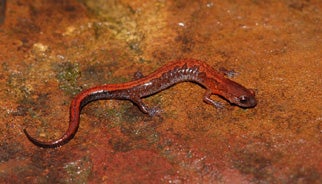SCIENTIFIC NAME:
Plethodon ventralis
STATUS:
Common. Until 1997, Alabama populations were known as northern zigzag salamander, P. dorsalis. Found in Interior Plateau and Southwestern Appalachians. Lowest Conservation Concern.
DESCRIPTION:
This is a small salamander between 2 ½-3 ½ inches long. The sides are brown to dark gray with a yellowish or orange colored striped running longitudinally down the dorsum. The stripe can vary from even-edged to a wavy or lobed appearance. The belly is light and mottled with dark pigment of varying intensity. Most Alabama specimens have 18 costal (associated with ribs) grooves.
DISTRIBUTION:
Occurs from Illinois and Indiana south to north and central Alabama, primarily in the uplands of the Southwestern Appalachians and Interior Plateau eco-regions. Until 1997, Alabama populations were known as northern zigzag salamanders, Plethodon dorsalis. The southern zigzag salamander is very common and is ranked as a species of lowest conservation concern.
HABITAT:
They prefer upland rocky woodlands dominated by hardwoods, most often encountered under rotten logs and rocks. They are also quite common near springs and mouths of caves.
FEEDING HABITS:
Zigzag salamanders forage along the forest floor in search of small insects.
LIFE HISTORY AND ECOLOGY:
Little is known about their reproductive history. They are known to be completely terrestrial, omitting the aquatic larval stage. Presumably, nesting occurs in subterranean cavities and passages, probably during the summer months.
REFERENCES:
Blaney, R. M. and K. Relyea. 1967. The Zig-zag Salamander, Plethodon dorsalis Cope, in Southern Alabama. Herpetologica, 23: 246-247.
Conant, Roger. 1975. A Field Guide to Reptiles and Amphibians of Eastern and Central North America. Houghton Mifflin Co., Boston, MA. 442-443 pp.
Mount, Robert H. 1996. The Reptiles & Amphibians of Alabama. The University of Alabama Press. Tuscaloosa, AL. 144-145 pp.
AUTHOR: Matt Brock, Wildlife Biologist, Alabama Division of Wildlife and Freshwater Fisheries






